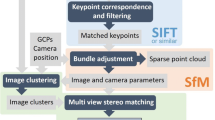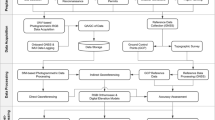Abstract
Easy-to-capture and robust plant status indicators are important factors when implementing precision agriculture techniques on fields. In this study, aerial red, green and blue color space (RGB) photography and near-infrared (NIR) photography was performed on an experimental field site with nine different cover crops. A lightweight unmanned aerial system (UAS) served as platform, consumer cameras as sensors. Photos were photogrammetrically processed to orthophotos and digital surface models (DSMs). In a first validation step, the spatial precision of RGB orthophotos (x and y, ± 0.1 m) and DSMs (z, ± 0.1 m) was determined. Then, canopy cover (CC), plant height (PH), normalized differenced vegetation index (NDVI), red edge inflection point (REIP), and green red vegetation index (GRVI) were extracted. In a second validation step, the PHs derived from the DSMs were compared with ground truth ruler measurements. A strong linear relationship was observed (R 2 = 0.80−0.84). Finally, destructive biomass samples were taken and compared with the remotely-sensed characteristics. Biomass correlated best with plant height (PH), and good approximations with linear regressions were found (R 2 = 0.74 for four selected species, R 2 = 0.58 for all nine species). CC and the vegetation indices (VIs) showed less significant and less strong overall correlations, but performed well for certain species. It is therefore evident that the use of DSM-based PHs provides a feasible approach to a species-independent non-destructive biomass determination, where the performance of VIs is more species-dependent.








Similar content being viewed by others
References
Bates, D., Mächler, M., Bolker, B., & Walker, S. (2015). Fitting linear mixed-effects models using lme4. Journal of Statistical Software, 67(1), 1–48. doi:10.18637/jss.v067.i01->.
Bendig, J., Bolten, A., & Bareth, G. (2013). UAV-based imaging for multi-temporal, very high resolution crop surface models to monitor crop growth variability. Photogrammetrie - Fernerkundung – Geoinformation, 2013(6), 551–562. doi:10.1127/1432-8364/2013/0200.
Bendig, J., Bolten, A., Bennertz, S., Broscheit, J., Eichfuss, S., & Bareth, G. (2014). Estimating biomass of barley using crop surface models (CSM) derived from UAV-based RGB imaging. Remote Sensing, 6, 10395–10412. doi:10.3390/rs60x000x.
Bendig, J., Yu, K., Aasen, H., Bolten, A., Bennertz, S., Broscheit, S., et al. (2015). Combining UAV-based plant height from crop surface models, visible, and near infrared vegetation indices for biomass monitoring in barley. International Journal of Applied Earth Observation and Geoinformation, 39, 79–87. doi:10.1016/j.jag.2015.02.012.
Bivand, R. (2015). rgrass7: Interface between GRASS 7 geographical information system and R. R package version 0.1-3. http://CRAN.R-project.org/package=rgrass7
Colomina, I., & Molina, P. (2014). Unmanned aerial systems for photogrammetry and remote sensing: A review. ISPRS Journal of Photogrammetry and Remote Sensing, 92, 79–97. doi:10.1016/j.isprsjprs.2014.02.013.
Dandois, J. P., & Ellis, E. C. (2010). Remote sensing of vegetation structure using computer vision. Remote Sensing, 2, 1157–1176. doi:10.3390/rs2041157.
Ehlert, D., Horn, H.-J., & Adamek, R. (2008). Measuring crop biomass density by laser triangulation. Computers and Electronics in Agriculture, 61, 117–125. doi:10.1016/j.compag.2007.09.013.
Freeman, K. W., Girma, K., Arnall, D. B., Mullen, R. W., Martin, K. L., Teal, R. K., et al. (2007). By-plant prediction of corn forage biomass and nitrogen uptake at various growth stages using remote sensing and plant height. Agronomy Journal, 99, 530–536. doi:10.2134/agronj2006.0135.
Geipel, J., Link, J., & Claupein, W. (2014). Combined spectral and spatial modeling of corn yield based on aerial images and crop surface models acquired with an unmanned aircraft system. Remote Sensing, 11, 10335–10355. doi:10.3390/rs61110335.
Gillan, J. K., Karl, J. W., Duniway, M., & Elaksher, A. (2014). Modeling vegetation heights from high resolution stereo aerial photography: An application for broad-scale rangeland monitoring. Journal of Environmental Management, 144, 226–235. doi:10.1016/j.jenvman.2014.05.028.
GRASS Development Team (2015). Geographic resources analysis support system (GRASS GIS) Software. Open source geospatial foundation. http://grass.osgeo.org
Hunt, E. R., Hively, W. D., McCarty, G. W., Daughtry, C. S. T., Forrestal, P. J., Kratochvil, R. J., et al. (2011). NIR-green-blue high-resolution digital images for assessment of winter cover crop biomass. GIScience & Remote Sensing, 48(1), 86–98. doi:10.2747/1548-1603.48.1.86.
Jensen, T., Apan, A., Young, F., & Zeller, L. (2007). Detecting the attributes of a wheat crop using digital imagery acquired from a low-altitude platform. Computers and Electronics in Agriculture, 59, 66–77. doi:10.1016/j.compag.2007.05.004.
Lal, R. (2015). A system approach to conservation agriculture. Journal of Soil and Water Conservation, 70(4), 82A–88A. doi:10.2489/jswc.70.4.82A.
Liebisch, F., Kirchgessner, N., Schneider, D., Walter, A., & Hund, A. (2015). Remote, aerial phenotyping of maize traits with a mobile multi-sensor approach. Plant Methods. doi:10.1186/s13007-015-0048-8.
Machado, S., Bynum, E. D., Archer, T. L., Lascano, R. J., Wilson, L. T., Bordovsky, J., et al. (2002). Spatial and temporal variability of corn growth and grain yield: Implications for site-specific farming. Crop Science, 42, 1564–1576. doi:10.2135/cropsci2002.1564.
Murakami, T., Yui, M., & Amaha, K. (2012). Canopy height measurement by photogrammetric analysis of aerial images: Application to buckwheat (Fagopyrum esculentum Moench) lodging evaluation. Computers and Electronics in Agriculture, 89, 70–75. doi:10.1016/j.compag.2012.08.003.
Pierpaoli, E., Carli, G., Pignatti, E., & Canavari, M. (2013). Drivers of precision agriculture technologies adoption: A literature review. Procedia Technology. doi:10.1016/j.protcy.2013.11.010.
Shahbazi, M., Théau, J., & Ménard, P. (2014). Recent applications of unmanned aerial imagery in natural resource management. GIScience & Remote Sensing, 51(4), 339–365. doi:10.1080/15481603.2014.926650.
Sona, G., Pinto, L., Pagliari, D., Passoni, D., & Gini, R. (2014). Experimental analysis of different software packages for orientation and digital surface modelling from UAV images. Earth Science Informatics, 7(2), 97–107. doi:10.1007/s12145-013-0142-2.
R Core Team (2015). R: A language and environment for statistical computing. R foundation for statistical computing, Vienna, Austria. https://www.R-project.org/
Thenkabail, P. S., Smith, R. B., & De Pauw, E. (2000). Hyperspectral vegetation indices and their relationships with agricultural crop characteristics. Remote Sensing of Environment, 71(99), 158–182. doi:10.1016/S0034-4257(99)00067-X.
Tilly, N., Aasen, H., & Bareth, G. (2015). Fusion of plant height and vegetation indices for the estimation of barley biomass. Remote Sensing, 7, 11449–11480. doi:10.3390/rs3030554.
Tilly, N., Hoffmeister, D., Cao, Q., Huang, S., Lenz-Wiedemann, V., Miao, Y., et al. (2014). Multitemporal crop surface models: accurate plant height measurement and biomass estimation with terrestrial laser scanning in paddy rice. Journal of Applied Remote Sensing. doi:10.1117/1.JRS.8.083671.
Tucker, C. J. (1979). Red and photographic infrared linear combinations for monitoring vegetation. Remote Sensing of Environment, 8, 127–150. doi:10.1016/0034-4257(79)90013-0.
Turner, D., Lucieer, A., & Watson, C. (2012). An automated technique for generating geo rectified mosaics from ultra-high resolution unmanned aerial vehicle (UAV) imagery, based on structure from motion (SFM) point clouds. Remote Sensing, 4, 1392–1410. doi:10.3390/rs4051392.
Vincini, M., & Frazzi, E. (2011). Comparing narrow and broad-band vegetation indices to estimate leaf chlorophyll content in planophile crop canopies. Precision Agriculture, 12, 334–344. doi:10.1007/s11119-010-9204-3.
Walter, A., Liebisch, F., & Hund, A. (2015). Plant phenotyping: From bean weighing to image analysis. Plant Methods, 11(1), 1–11. doi:10.1186/s13007-015-0056-8.
Walter, A., Studer, B., & Kölliker, R. (2012). Advanced phenotyping offers opportunities for improved breeding of forage and turf species. Annals of Botany, 110(6), 1271–1279. doi:10.1093/aob/mcs026.
White, J. W., Andrade-Sanchez, P., Gore, M. A., Bronson, K. F., Coffelt, T. A., Conley, M. M., et al. (2012). Field-based phenomics for plant genetics research. Field Crops Research, 133, 101–112. doi:10.1016/j.fcr.2012.04.003.
Wolf, P. R., & Dewitt, B. A. (2000). Elements of photogrammetry: With applications in GIS (3rd ed.). Boston: McGraw-Hill.
Yin, X., McClure, M. A., Jaja, N., Tyler, D. D., & Hayes, R. M. (2011). In-season prediction of corn yield using plant height under major production systems. Agronomy Journal, 103(3), 923–929. doi:10.2134/agronj2010.0450.
Acknowledgements
The authors would like to thank Nicole Berger for maintaining the UAS as well as executing the flight campaigns, Daniel Schwab for providing his land as the experiment field and for seeding, raising and taking care of the crops, Eric Schweizer AG for the donations of cover crop seedlings, Fabienne Bauer, Matthias Botta and Dominique Flury for helping with field work and Paulette M. Kirkby and Elizabeth Steele for English editing.
Author Contributions
LR designed and maintained the experiment, designed and implemented the method and performed the analyses, figures and tables. The manuscript was drafted by LR with help and contributions from BS. Both authors read and approved the final manuscript.
Author information
Authors and Affiliations
Corresponding author
Ethics declarations
Conflicts of interest
The authors declare no conflict of interest.
Appendix
Appendix
See Fig. 9.
Rights and permissions
About this article
Cite this article
Roth, L., Streit, B. Predicting cover crop biomass by lightweight UAS-based RGB and NIR photography: an applied photogrammetric approach. Precision Agric 19, 93–114 (2018). https://doi.org/10.1007/s11119-017-9501-1
Published:
Issue Date:
DOI: https://doi.org/10.1007/s11119-017-9501-1





